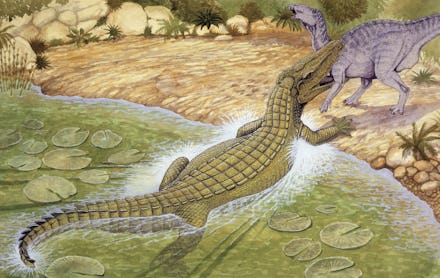New research shows "terror crocodiles" had teeth the size of bananas

Crocodiles with teeth the size of bananas were apparently a nightmare that actually existed during the Late Cretaceous period. A pair of researchers with the University of Iowa decided to re-examine existing fossils of the Deinosuchus, a prehistoric ancestor of crocodiles and alligators estimated to be about 33-feet-long and nicknamed the "terror crocodile." Their findings, published recently in the Journal of Vertebrate Paleontology, suggest at least three different species of Deinosuchus roamed the waters of North America.
"Deinosuchus was a giant that must have terrorized dinosaurs that came to the water's edge to drink," study lead Dr. Adam Cossette said in a press release. "Until now, the complete animal was unknown," he added. "These new specimens we’ve examined reveal a bizarre, monstrous predator with teeth the size of bananas."
Bananas! Teeth should not be that big.
"At the time it was living here in the eastern US, there was nothing bigger," Dr. David Schwimmer, a paleontologist and geologist, told the Ledger-Enquirer. In fact, current estimates place the crocodile's size at about the same length of a conventional school bus.
Dr. Schwimmer was not involved with the study, but has contributed multiple articles and a book on Deinosuchus. His work in the field is so highly appreciated that the researchers of the study named one Deinosuchus species after him in his honor — the Deinosuchus schwimmeri.
"We actually have bite marks from these guys on dinosaur bones. Now, the only question you can ask: Were they scavenging or predatory?" Dr. Schwimmer wondered.
"My guess is predatory… This creature was big enough to take down most dinosaurs. Also, interestingly enough, most of the bites we see are in leg bones and tailbones. If you're going to grab a dinosaur, that's the place you're going to grab them."
The authors of the study appear to agree, describing the Deinosuchus as a "semiaquatic ambush predator" in their report. The different species also showed varying characteristics depending on where they lived. A Deinosuchus on the East Coast could be a different size than one on the West Coast, for example.
These notable differences, as well as its unusual alligator-like appearance, makes this prehistoric crocodile an important piece of evidence against the belief that crocodylians haven't evolved much since the prehistoric days.
"It was a strange animal," noted co-author Dr. Christopher Brochu. "It shows that crocodylians are not 'living fossils' that haven't changed since the age of dinosaurs. They've evolved just as dynamically as any other group."
"Crocodiles are actually these incredibly dynamic creatures that have experienced incredible evolutionary histories, have lived in places that modern crocodiles don't live, done things that modern crocodiles don't do and have grown to sizes that modern crocodiles never achieve," Dr. Cossette told NPR.
"This study shows that the ancestors of today's American alligator didn't look anything like them."